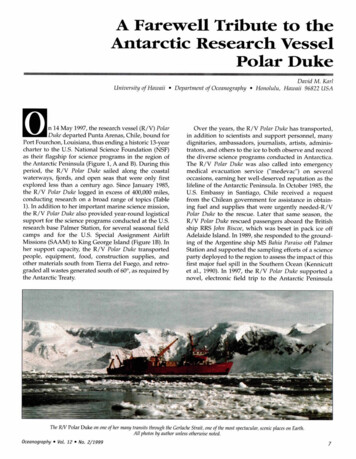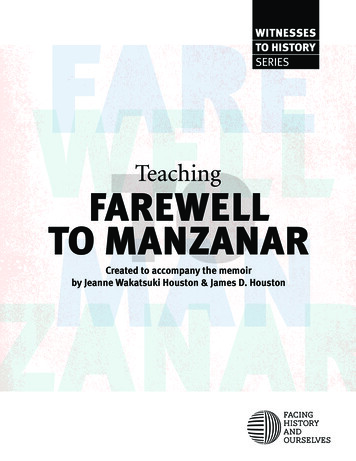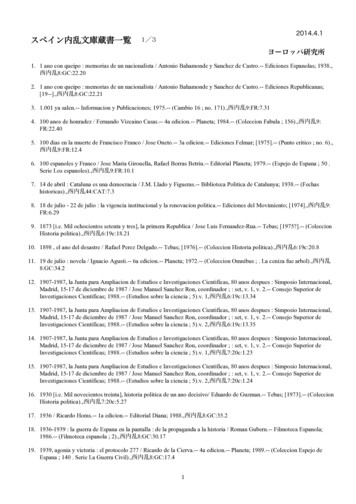
Transcription
A Farewell Tribute to theAntarctic Research VesselPolar DukeDavid M. KarlUniversity of Hawaii Department of Oceanography Honolulu, Hawaii 96822 USA n14 May 1997, the research vessel (R/V) PolarDuke departed Punta Arenas, Chile, bound forPort Fourchon, Louisiana, thus ending a historic 13-yearcharter to the U.S. National Science Foundation (NSF)as their flagship for science programs in the region ofthe Antarctic Peninsula (Figure 1, A and B). During thisperiod, the R/V Polar Duke sailed along the coastalwaterways, fjords, and open seas that were only firstexplored less than a century ago. Since January 1985,the R/V Polar Duke logged in excess of 400,000 miles,conducting research on a broad range of topics (Table1). In addition to her important marine science mission,the R/V Polar Duke also provided year-round logisticalsupport for the science programs conducted at the U.S.research base Palmer Station, for several seasonal fieldcamps and for the U.S. Special Assignment AirliftMissions (SAAM) to King George Island (Figure 1B). Inher support capacity, the R/V Polar Duke transportedpeople, equipment, food, construction supplies, andother materials south from Tierra del Fuego, and retrograded all wastes generated south of 60 , as required bythe Antarctic Treaty.Over the years, the R/V Polar Duke has transported,in addition to scientists and support personnel, manydignitaries, ambassadors, journalists, artists, administrators, and others to the ice to both observe and recordthe diverse science programs conducted in Antarctica.The R/V Polar Duke was also called into emergencymedical evacuation service ("medevac") on severaloccasions, earning her well-deserved reputation as thelifeline of the Antarctic Peninsula. In October 1985, theU.S. Embassy in Santiago, Chile received a requestfrom the Chilean government for assistance in obtaining fuel and supplies that were urgently needed-R/VPolar Duke to the rescue. Later that same season, theR/V Polar Duke rescued passengers aboard the Britishship RRS John Biscoe, which was beset in pack ice offAdelaide Island. In 1989, she responded to the grounding of the Argentine ship MS Bahia Paraiso off PalmerStation and supported the sampling efforts of a scienceparty deployed to the region to assess the impact of thisfirst major fuel spill in the Southern Ocean (Kennicuttet al., 1990). In 1997, the R/V Polar Duke supported anovel, electronic field trip to the Antarctic PeninsulaThe R/V Polar Duke on one of her many transits through the Gerlache Strait, one of the most spectacular, scenic places on Earth.All photos by author unless otherwise noted.Oceanography VoL 1 2 No. 2 / 1 9 9 97
Drake Passage BransfieldStrait/dDeception" 'AnversIsLar SOUIt/ IFL,4I/I/COCEANI/f,/Ik, . , . A-"-L. atlo FR ICAk t r or .}so SOUTH d"-.co., Ez ,s\Wedde# SeaAdelaideIsland HEA D1East'Base,, '"\, - , }" / ""%,'- Macg 'a :\J!.\ . / I CL4,Figure 1: (A) Map of the Antarctic continent showing a few of the major areas of R/V Polar Duke science support over the past 13 years. (B) Enlargedportionof the Antarctic Peninsula commonly known as "Duke Place."via interactive television and on-line networks.The "Live From Antarctica 2" broadcasts providedan unprecedented view of life aboard the researchvessel and science activities on the ice to studentsaround the world; "real science, real scientists, reallocations and real time" in the true spirit of the NSFsupported Passport to Knowledge series (for morei n f o r m a t i o n , contact the LFA-2 website athttp: / / quest, arc. nasa. gov / antarctica2).The "Duke," as she was fondly called by the men andwomen of the National Science Foundation's U.S.Antarctic Program (USAP), will be remembered as acapable and comfortable vessel with an extremely professional, "user-friendly" crew. This commitment toexcellence, combined with the expert science supportservices provided by the USAP contractors ITTAntarctic Services (1985-1990) and Antarctic SupportAssociates (1991-1997) and their capable Chileanmaritime port servicing agents (COMAPA and AGUNSA) is the main reason why many oceanographers ratethe R/V Polar Duke a truly exceptional research vessel.Her legacy of scientific achievement is remarkable, inpart, because of the unique opportunities and challenges that arose during the period of her service,especially with issues related to global environmental8change. She has transported ice and sediment cores thatchronicle the history of earth's climate, petrified woodand animal fossils that support the theory of continental drift, and modern day biological specimens that areproviding important clues to the nature of life in theSouthern Ocean. This farewell tribute will chronicle afew of the many scientific programs that were wellserved by the officers and crew of the Duke and will provide a few words of gratitude for a job well done. A" R / V Polar Duke Farewell Tribute" World est.hawaii.edu/polarduke), and allwho sailed aboard her are welcome to contribute theirphotos, accolades, and sea stories directly to the webmaster (see web page for additional instructions).History of U.S. Science Missionin the Antarctic PeninsulaU.S. interests in the Antarctic Peninsula date back tothe early portion of the 19th century and to the discovery of the Antarctic continent itself. Before achieving itspresent status as a continent for international scientificdiscovery, Antarctica was the domain of whalers, sealers, and explorers. The name "Antarctica" is derivedOceanography Vol. 12 No. 2/1999
In 1963, the United States established an atmospherfrom the Greek Antarktos-literally translated meaningic research station called Eights Station (named afteropposite Arktos, the constellation in the northern sky.James Eights, the first American scientist to work inAs early as 150 A.D., Antarctica appeared on Ptolemy'sAntarctica) at the base of the Antarctic Peninsula nearworld map despite objections by "flat earth" orthodoxy78 W, 78 18'S (Jones, 1964). During that same field seaand other theological views of that period. High latison, a broad reconnaissance was conducted in thetude Southern Ocean expeditions led by FerdinandPeninsula region for locations to site additional researchMagellan (1519-1522) and Francis Drake (1577-1580),bases. From an examination of 30 potential sites, Arthurand the circumnavigation of the Antarctic continent byHarbor on the southwestern coast ofCaptain James Cook (1772-1774) allAnvers Island emerged as the mostfailed to sight the Antarctic continent.Until the R / V P o l a r D u k edesirable location (Jones, 1964), and inIn 1820, a 19-year-old New Englandwas brought into service,1965, a small prefabricated woodensealer, Nathaniel Palmer, sailed to thethe Peninsula-based researchstructure was erected at Norsel PointPeninsula region aboard his 14-mprograms were largely centeredon Anvers Island (Figure 1B), near thesloop, Hero. Although there is somesite of the abandoned British Antarcticdebate on this point, he and his fiveat Pahner S t a t i o n . . .Survey's Base "N" that was establishedman crew may have been the first tothere during the IGY. Thus began a major U.S. presencesee the Antarctic continent after more than three cenin the Antarctic Peninsula. Three years later, U.S. scituries of serious exploration (note: the British Captainsence activities in the Peninsula were transferred to theWilliam Smith and Edward Bransfield, and the Estonianpresent Palmer Station, which was constructed a fewCaptain Thaddeus Bellingshausen have also been sokilometers away from "Old Palmer."credited).In March 1968, the R/V Hero was launched in SouthIt was nearly 75 years before any comprehensive sciBristol, Maine to serve as a support vessel for U.S.entific expeditions were conducted in the Antarcticresearch activities in the Antarctic Peninsula. The R/VPeninsula region. Among the first were the BelgianHero (38m, 300 LT displacement) had a ketch-rigged,Antarctic expedition in 1897 headed by Adriendiesel-powered trawler-type design and was frameddeGerlache, which included Henryk Arctowski andwith native oak timbers. Her masts and interior workRoald Amundsen as members of the party, the Scottishwere of Oregon fir, and her sides were reinforced withNational Antarctic Expedition (1902-1904) in theGuayanan greenheart for added hardness and durabiliWeddell Sea headed by William Bruce, and severalty; she had accommodations for six scientistsFrench expeditions headed by Jean Charcot. The U.S.(Anonymous, 1968). The R/V Hero arrived at PalmerAntarctic Service Expedition in 1939-1941 established aStation on Christmas day, 1968 and served the U.S."permanent" base (East Base) on Stonington Island inAntarctic program with great distinction for nearly twoMarguerite Bay during Admiral Richard Byrd's thirdAntarctic expedition (Figure IB). This was the firstdecades. Although the R/V Hero was able to conduct apermanent U.S. base on the Antarctic Peninsula. Frommodest level of oceanographic research, conditionsaboard her were less than ideal, especially consideringthis location in 1947-1948, the famed explorer Captainthe generally inclement weather in the Southern Ocean.Finn Ronne conducted a remarkable 84-day sledge jourConsequently, until the R/V Polar Duke was brought intoney to Alexander Island (Lipps, 1976). East Base alsobecame famous as the site where the first women winservice, the Peninsula-based research programs weretered in Antarctica (Mrs. Ronne and Mrs. Darlington),largely centered at Palmer Station, where scientists hadand one left the ice pregnant (Lipps, 1976). The U.S.access to a variety of seabird rookeries, intertidal/subtiOperation Highjump (1946-1947), including 4,700 men,dal marine habitats and, most importantly, laboratories33 aircraft, and 13 ships, marked the beginning of modand support personnel.ern scientific research in Antarctica. This post-warassault on the continent focused on terrestrial, notThe Duke Chartermarine, activities. The declaration of the ThirdThe R/V Polar Duke was christened in 1983 at YardInternational Geophysical Year (IGY; July 1957 toDecember 1958), organized to coincide with peakNo. 55 (VaagenVerft A/S) in Kyrksoterora, Norwaysunspot activity, facilitated the first coordinated, inter(Figure 2). The vessel was initially designed and condisciplinary studies of the southern continent. Twelvestructed for service in north polar seas as part of a fleetcountries established 40 bases, including the U.S.of research and supply vessels that were owned andAmundsen-Scott South Pole Station. Dr. Laurence M.operated by Rieber Shipping A / S of Bergen, Norway.Gould headed the U.S. IGY delegation. The IGY stimuAs North Sea oil exploration waned, Rieber consideredlated the creation of the Antarctic Treaty, which wasalternative uses for their fleet of ice-strengthened vesapproved by representatives of the 12 IGY partnersels, and in 1984 NSF approved charter of the R/V Polarnations in 1959. This treaty established the legalDuke (67m, 1600 LT displacement) as a replacement forprecedent and protocol for international scientific coopthe R/V Hero, which was being retired after nearly 20eration south of 60 S.years of Antarctic service.Oceanography VoL 12 No. 2/19999
Despite the loss of the Duke from the USAP program,At the time of the initial 3-year charter agreement inAntarctic scientists have reason to be optimistic about1985, the Duke was operated by Carino Shipping Ltd.,the future. A new ice-strengthened research vessel (classSt. John's, Newfoundland (CAnada-RIeber-NOrway, aABS A-l), Laurence M. Gould (71m, 3400 LT displacewholly-owned subsidiary of Rieber Shipping A/S),ment), has replaced the Duke for an initial five-yearand sailed under a Canadian flag with a predominantcharter in December 1997. The R/V Laurence M. Gould isly Canadian crew. In 1989, the vessel was reflaggedoperated by Edison Chouest Offshore, Galliano,Norwegian international, and from that point on sheLouisiana for the USAP under a subcontract withsailed largely with a Norwegian crew supplementedAntarctic Support Associates. Those sometimes exoticwith Chilean cooks, messmen, oilers and able-bodiedNorwegian entrees and vintage Chilean Cabernets (limseamen. In the shadows of Nansen, Amundsen, Larsen,ited to 3 oz. per dinnerandotherfamousmeal) have given wayNorwegian explorers,to red beans, rice, andthe officers and crew ofCoca Cola as the scienthe R / V Polar mthemselves over themoved from the Rieberyears by dedication andto the Chouest vesseldetermination in purcharter agreement.suit of their science support mission.The initial charterThe Drake Passagerequirement was for theAccordingtotheR/V Polar Duke to perAntarcticPilot,"navigaform austral summertion in the Southernresearch and resupplyOceanis rendered diffitasks similar to thosecultbysea ice, suddenassigned previously toviolentand unprethe R/V Hero. Her firstdictablechanges inseason-threecruisesweather,anunusuallybetween Punta Arenas,highproportionof danChile, and the AntarcticgerousshoalsrisingPeninsula from Januaryprecipitouslyfromdeepto April 1985-conformedwater,largeseasandto this minimal expectaswells,instabilityofthetion. However, by thecompassathighlatiend of her first year, the Figure 2: The R/V Polar Duke is an ice-strengthened vessel with accommodationsJbrinadequatecapabilities of the R/V 26 scientists. Diesel propulsion and thrusters fore and aft provide excellent maneuver- tudes,chartsandlackof naviPolar Duke were chal- ability and station keeping. Photo by Reiber Shipping A/S.gationalaids."It goeslenged by a rare eresearch cruise (L. Quetin, Chief Scientist) (see Parfit,great care when navigating in these waters." Despite all1986), which was followed by a second winter cruisesafety precautions that are routinely taken, work induring her third field season (June to July 1987). The sucAntarctica is still very hazardous. The R/V Polar Dukecess of these winter expeditions established what evenand the entire U.S. Antarctic Program pride themselvestually became a year-round science mission in theon their excellent safety records to date.Antarctic Peninsula (Table 1). Since 1988-1989, the PolarA major obstacle, if not impediment, for science operDuke has typically spent 275-300 days at sea per annumationsin the Peninsula region of Antarctica is the Drakein support of USAP science programs, and during thePassage.This malevolent portion of the global ocean,1989-1990 operating year she was at sea for 339 days.locatedbetweenCape Horn to the north and the SouthThis extended season was due, in part, to her support ofShetlandIslandsto the south (Figure 1, A and B) is,an interdisciplinary expedition from Palmer Station towithoutadoubt,oneof the most inhospitable places onthe Ross Sea and her first ever port call at McMurdoEarth.Althoughonrareoccasion the Drake Passage isStation (Figure 1A). In June 1995, the R/V Polar Duke leftsunnyandcalm,itusuallyis quite the opposite. Stormsthe southern hemisphere, temporarily, to deliver a shipmoveinamoreorlesscontinuoussuccession from westment of hazardous wastes to the U.S. mainland for finaltoeastatalatitudeofapproximately60 S in the Pacificprocessing and disposal. The bright sunny skies andsectoroftheSouthernOcean.Overcastsky and lowwarm seas that accompanied her on her journey acrossbarometricpressures( 985mb)arepossible;gales arethe equator thawed the decks and gained her the served nickname, "R/V Solar Duke."10Oceanogrophy Vol. 12 No. 2/1999
Cape Horn rollers, are legendary. They can achievelengths of 1 nmi, crest to crest, and reach heights of 25m (Lansing, 1959). As Charles Darwin wrote on firstobserving the Drake's fury in 1833, "The sight is enoughto make a landsman dream for a week about death,peril and shipwreck," or as Patricio Rojas, a cook aboardthe R / V Polar D u k e , recently proclaimed in a pressrelease on Wild Antarctica, "The Drake Passage makesthe living wish they were dead, and makes an atheistbelieve in God!" Every time I make the crossing I thinkabout Shackleton and his men who made a forced crossing of the Drake Passage from Elephant Island to SouthGeorgia in their open, 6m dory, James Caird. That helpsto place m y own misery into a broader and more realistic perspective.Occurrence and Consequenceo f the Ozone H o l eOzone, a triatomic form of oxygen (O3), OCCURS naturally in the earth's stratosphere and elsewhere. Ozone isboth an important oxidant and a precursor for otherreactive compounds, and plays a crucial role in atmospheric photochemistry (Molina and Rowland, 1974;Schnell et al., 1991). Ozone is essential for life on earth;it absorbs both infrared and UV-B (280-320 nm) radiation and, consequently, helps to drive the global circulation of the upper atmosphere. The amount of ozone atany one location on earth is called the "total ozone column" and is expressed as the height of O3 at standardtemperature and pressure measured in 10 .2 m, orDobson units (DU). The amount of 03, present at anygiven time and place is a complex balance betweenSelected Scientific Benchmarksnumerous sources, sinks, and transport processes.It is impossible to review or even mention all of theGeographical, seasonal, and interannual variations inscientific accomplishments of the many investigatorsO3 are both expected and observed.who have conducted research aboard the R/V PolarSuperimposed on these natural O3 dynamics is theD u k e during her 13 years of service. Interested readersdiscovery, by Farman and co-workers, of the episodicare encouragedloss of 03 eachto consult theaustral summerannual reviewover Antarcticaissues of the(Farman et al.,Antarctic1985; SolomonJournal of theet al., 1986). ThisUnitedStatesloss of stratosfor summariespheric O3, theof the results ofso-called "ozonethesediversehole," is attribfield programsuted to O3 de(see Table i for astructionbyfew examples).chlorine radicalsThere are, howvia chemicalever, at leastcatalysis. Thesetwo areas ofreaction mecharesearchthatnisms were firstdeservemendescribed by M.tion not onlyMolina and F.S.because of theirRowlandinsignificance, but1974, researchalso because offor which theytheirmuchlaterwerebroader implica- R/V Polar Duke calls at Pahner Station (64 46'S, 64 '03'W), the U.S. research base in the Antarcticawardedthetions to earth Peninsula. Established in 1968, this station now supports a diverse range of science projects from marine 1 9 9 5 N o b e lbiology to meteorology and upper atmosphere studies. It is also the site of several large penguin rookeriesand ocean sci- and, since 1991, the site of a NSF Long Term Ecological Research (LTER) project.Prizeinences.TheseChemistrytopics include 1)along with P.Antarctic stratospheric ozone depletion, increased surCrutzen, another ozone chemistry pioneer. These naturface ultraviolet solar irradiance, and effects on ecosysal O3-destroying reactions are now known to be stimutem processes; and 2) biogeochemical processes, carlated by release into the atmosphere of manmadebon fluxes, and the structure and function of Antarcticchlorofluorocarbons (CFCs), thereby providing afood webs. Both of these broad research topics havecompelling case study for our direct intervention onbeen studied extensively by investigators workingearth's climate.aboard the R/V Polar D u k e since 1985.During the annual development of the AntarcticOceanography Vol. 12 No. 2 / 1 9 9 911
TABLE 1Selected research programs supported by the R/V Polar Duke during her service to the U.S. National Science Foundation'sAntarctic Program (1985-1997)Project TitleMarine Geology & GeophysicsMarine heat flowPaleoclimate history of southern ChileStratigraphy in Antarctic fjordsMarine geology of Antarctic continental marginsMarine ChemistryParticulate matter fluxCycling of biogenic silicaIron and phytoplankton productionPhysiological ecology of ultraviolet absorbing compoundsHydrocarbons in the Antarctic Peninsula regionMarine BiologyAntifreeze proteins in Antarctic fishesEnergetics of Antarctic krillPhysiology of ice algaeBehavioral ecology of Weddell sealsMicrobial chitin degradationLife history of Antarctic fishesBiology of gelatinous zooplanktonMeteorology/OceanographyMarine sources of sulfate aerosolNetwork for monitoring ultraviolet radiationPhotochemistry of Antarctic watersOzone depletion and phytoplankton biologyCloud condensation nuclei: a link between ocean-sulfate and climateOceanographyTrophic coupling between mesopelagic and sea-ice communitiesLong-term ecological research on the Antarctic marine ecosystemResearch on Antarctic coastal ecosystem ratesHydrothermal vents in the Bransfield StraitsFormation of Antarctic bottom waterEcology of marine Antarctic archebacteriaozone hole, there can be complete loss of O in the lowerstratosphere and up to 50% loss of total column O ,(from typical winter values of 300 DU to springtimeminima of 150 DU) during a period of less than sixweeks generally beginning in late August. The size ofthe Antarctic ozone hole has been increasing since theearly 1980s (Jiang et al., 1996), and this has stimulatedresearch into this important area.Changes in total column 03 concentrations havedirect effects on UV-B irradiance at the earth's surfaceand, hence, implications for UV-B d e p e n d e n t photochemistry and photobiology. Ozone selectively absorbsUV-B and does not alter visible light (400-700 nm);consequently, O: depletion selectively increases UV-Bfluxes. A major body of literature exists on the effects ofUV-B radiation on the physiology and growth of a vari-12Principal InvestigatorL. LawverA. LeventerE. DomackJ.B. AndersonR. DunbarD. Nelson, D. DemasterJ.H. MartinD. KarentzM. KennicuttA. DeVriesR. Ross, L. QuetinC. SullivanJ.W. TestaJ.T. StaleyR. RadtkeR. HarbisonH. BerresheimC.R. BoothK. Mopper, D. KieberR. Smith, B. PrdzelinV. SaxenaK. SmithR. Ross/R. Smith and othersM. Huntley and othersG. KlinkhammerT. FosterE. DeLongety of marine organisms (Voytek, 1990; Hfider andWorrest, 1991), but less is k n o w n about the ecologicalconsequences. An a u t h o r i t a t i v e r e v i e w of presentknowledge has recently appeared (Karentz et al., 1994).In response to a recognized need to obtain more information on the potential ecological impacts of theAntarctic ozone hole, a ground-based scanning spectroradiometer (280-700 n m with 0.75 n m bandwidth) wasd e p l o y e d at Palmer Station in May 1988 as part of theUSAP UV monitoring network to measure the ozonehole in the Peninsula region (Booth et al., 1994). Withthe aid of this instrument, Frederick and Lubin (1994)were able to d o c u m e n t a springtime period of enhancedsolar UV irradiance at Palmer Station that coincidedwith the atmospheric ozone depletion. At the sametime, several important studies were initiated aboardOceanography VoL 12 No. 2/1999
discovered were the mycosporine-like amino acids. Athe R/V Pohzr Duke, and at Palmer Station, the results offield survey of a variety of marine algae and higherwhich have provided new insights into this complexorganisms, also conducted aboard the R/V Polar Dukeand important environmental problem.and at Palmer Station, demonstrated a widespreadHolm-Hansen et al. (1989) were among the first tooccurrence of these natural sunscreensrecognize the importance of UV-B(Karentz et al., 1991). A more recentradiation on rates of photosynthesis . . several important studiescomparison of the effects of UV radiain Antarctic marine phytoplankton.were initiated aboardtion on phytoplankton derived fromSubsequent field studies further docthe R/V Polar Duke,short-term (1 day) versus long-term (2umented a significant UV radiationand at Palmer Station,weeks) incubations revealed that cells(both UV-A and UV-B) inhibition oncan acclimatize and adapt to increasedthe rate of phytoplankton growththe results of whichUV fluxes (Villafafie et al., 1995).(Helbling et al., 1992, 1994). On sunnyhave provided new insightsConsequently,thelong-termdays when total UV radiation wasecological impacts may be less thanhigh ( 10-15 W m2), photosynthesis into this complex and importantenvironmental problem.initially believed. Clearly more studwas increased 200-300 ."o by theies are warranted before any predicremoval of all UV light ( 378 nm)tive ecosystem models can be developed.using selective filters. However, when the total UVradiation was lower ( 10 W m :), more typical of partlyIn addition to these studies on the effects of UV-B radiation on phytoplankton, recent investigations aboard thecloudy days, no effect was observed. They also reportR/V Polar Duke have documented other potentiallyed that UV radiation was more inhibitory toimportant impacts on a variety of populations andmicroplankton (primarily diatoms) than to nanoplankton (primarily flagellates), a result that may have impliprocesses. Bacteria, the primary consumers of dissolvedorganic matter in marine ecosystems, are known to becations for food web dynamics especially consideringsusceptible to UV radiation, and Southern Ocean bactethe important role of microplankton as a food sourceria are no exception. Field studies conducted during thefor Antarctic krill and other large herbivores (HelblingR/V Polar Duke-supported DIMERS expeditionet al., 1994). Because UV-B radiation is rapidlyabsorbed in the upper 10-20 m of the water column,(Damage In Microorganisms from Environmentaldepending on the amount of dissolved organic matterRadiation in the Southern Ocean; W. Jeffrey, Chiefand other properties, the effective dose of UV radiationScientist) have documented a significant inhibition ofheterotrophic growth and metabolism and measuredis difficult to determine unless relevant complementarymeasurements (e.g., ocean mixing rates) are made atproduction of W-induced photoproducts in bacteriaunder the Antarctic ozone hole. Another effect on bacterthe same time. According to Bidigare (1989), a quantitative assessment of the effects of UV-B enhancemential population dynamics may be via the interactions ofwill require knowledge of 1) the wavelength-depenUV radiation and infectious viruses. Because they lackdent flux of UV-B in the ocean, 2) action spectra for UVDNA repair mechanisms, viruses may be especially susB damage to Antarctic organisms, and 3) depth-depenceptible to ozone hole enhancements in UV-B radiation.dent distributions and residence times of organisms inTo the extent that virus infection is a major control onthe mixed layer.plankton populations, changes in their infectivity ratesBased on the results of their "Icecolors-90" cruise incould influence ecosystem dynamics and carbon fluxes.the Bellingshausen Sea aboard the R/V Polar DukeThe decreased abundances of virus particles observed in(October to November 1990), Smith et al. (1992) reportthe surface waters of the Antarctic Peninsula (Bird et al.,ed that the Antarctic ozone hole has resulted in shifts of1993) are consistent with this model.in-water spectral irradiances that had affected AntarcticMalloy et al. (1997) have recently presented the firstmarine ecosystem processes including a minimumdirect evidence that increased UV-B radiation may6-12 /,, reduction in primary production during thedamage the DNA of higher organisms within a naturalperiod of their observations. However, because thepopulation of Antarctic zooplankton. Studies conductmaximum in enhanced UV-B radiation occurs at a timeed aboard the R/V Polar Duke demonstrated that theof the year (early spring) when phytoplankton produceggs of the Antarctic icefish are susceptible to ozonetion rates are relatively low, the impact on total annualinduced UV-B radiation increases resulting in DNAorganic matter production may be negligible (Holmdamage, identical to that observed in microorganisms.Hansen et al., 1993). The comprehensive field study ofConsequently, enhanced UV-B fluxes may affect recruitSmith et al. (1991) examined not only the short-termment as well as transfer of organic matter to highereffects of increased UV-B radiation, but also the equallytrophic levels. Finally, the increased levels of UV-B radiimportant photoregulatory ecological processes, includation in Antarctic waters may also significantly magnifying UV-A and UV-B induced photoprotectivethe rates of euphotic zone photochemical processes (inmechanisms (see also Pr6zelin et al., 1994). Among theaddition to DNA dimerization), which, in turn, maymost effective photoprotectant organic compoundshave either negative or positive effects on the associat-Oceonogrophy VoL 12 No. 2/199913
flow through microheterotroph (bacterial) and protoed populations. One interesting but unpredictable effectzooplankton (flagellate and ciliate) assemblages. In fact,is the partial photolysis of otherwise refractory diswe can expect our views on the strucsolved organic matter to produceIn 1989, the R / V P o l a r D u k etural complexity of the Antarctic foodlabile, low molecular weight subsupportedfieldresearchwebto expand further as we incorpostances such as pyruvate (Kieber,ratenewecosystem processes current1994). The formation of these labileconducted by personnellyunderinvestigation.The concept ofprecursors could, in turn, stimulatefrom John Martin's trophic bacterial production tenable,these reduced carbon-limited ensive,quantitativestudand potentially, decouple photoauiesofenergyandcarbonflowthroughtotrophic and chemoheterotrophiccontrol primary productionthe entire Antarctic food web still doprocesses. This coupled photochemiin Antarctic ecosystems.notexist. This information is crucialcal-bacterial processing of this largeforunderstandingthestructure and efficiency of thereservoir of organic matter could have a major effect on"bi
University of Hawaii Department of Oceanography Honolulu, Hawaii 96822 USA n 14 May 1997, the research vessel (R/V) Polar Duke departed Punta Arenas, Chile, bound for . ("medevac") on several occasions, earning her well-deserved reputation as the lifeline of the Antarctic Peninsula. In October 1985, the











